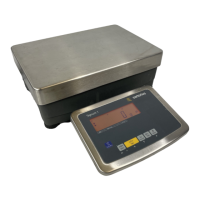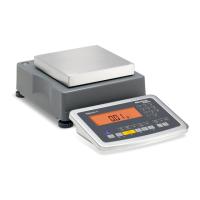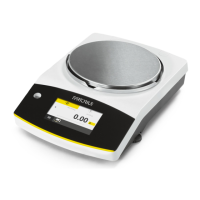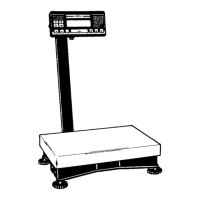Application 2: Checkweighing O
Application 2: Checkweighing O
66
Minimum Load
The minimum load required for
automatic taring of the container
weight on the platform (first weight),
or for automatic printout of results,
is configured in Setup under:
Appl: O:: 3.5.
Signum
®
3:
Appl
: m.weigh: 3.5.
You can choose from the following
10 levels for this setting:
1 digit (no minimum load)
2 digits
5 digits
10 digits
20 digits
50 digits
100 digits
200 digits
500 digits
1000 digits
The “digits” here refer to the scale
intervals in the connected weighing
platform. If the interval of the
connected platform is 1 g, for example,
and 1000 digits are required, you must
place at least 1000 g (= 1000 intervals
=1000 digits) on the weighing platform
to activate autotaring or autoprint.
Display
The result of a measurement is shown
either as a weight value or in relation to
the target.
– Weight display
The measured value line always shows
the weight value, even if it lies outside
the tolerance range.
The bar graph is displayed with symbols
indicating lower limit, target and upper
limit. Weights are shown logarithmically
up to the lower tolerance limit, and
linearly beyond that point.
– Relation to target value
As “Weight display” above, with the
exception that:
– LL appears in the main display if the
weight value is less than the target
– HH is shown on the main display if
the weight value is higher than the
target
Digital I/O
Interface
The Checkweighing application
supports the digital input/output-
interface.
There are 4 control lines, or outputs,
which are activated as follows (see also
the diagram below):
– Lighter
– Equal
– Heavier
– Set
In Setup, under:
Appl: O:: 4.4.
Signum
®
3:
Appl 2:
check.wg: 4.4.
you can define whether these control
ports are
– switched off
– always on
– on at stability
– on within checkweighing range
– on at stability within checkweighing
range
The “SET” output normally changes its
voltage level when the load is near the
target weight. Alternatively, you can
assign the “Ready for use” function to
this port. Configured in Setup under:
Appl: O:: 4.3.
Signum
®
3:
Appl 2:
check.wg: 4.3.
This makes it possible, for example, to
connect a simple indicator for weighing
or calculation results.
All data output ports have a high
voltage level when:
– The application has not been initialized
– The weighing instrument is not at
stability and the “at stability ...”
parameter is selected
– The weight is not within checkweighing
range
Digital I/O Interface
– <SET> control output set
– Port lines: within checkweighing range
Output port specifications:
– When not in use, the voltage level is
high: >3.7 V/+4 mA
– When activated, the voltage level is low:
<0.4 V/–4 mA
! The data outputs are not protected
from short circuits.
66
Minimum Load
The minimum load required for
automatic taring of the container
weight on the platform (first weight), or
for automatic printout of results, is
configured in Setup under:
Appl: O: 3.5.
Signum
®
3:
Appl
: m.weigh: 3.5.
You can choose from the following 10
levels for this setting:
1 digit (no minimum load)
2 digits
5 digits
10 digits
20 digits
50 digits
100 digits
200 digits
500 digits
1000 digits
The “digits" here refer to the scale
intervals in the connected weighing
platform. If the interval of the
connected platform is 1 g, for example,
and 1000 digits are required, you must
place at least 1000 g (= 1000 intervals
=1000 digits) on the weighing platform
to activate autotaring or autoprint.
Display
The result of a measurement is shown
either as a weight value or in relation to
the target.
– Weight display
The measured value line always shows
the weight value, even if it lies outside
the tolerance range.
The bar graph is displayed with symbols
indicating lower limit, target and upper
limit. Weights are shown logarithmically
up to the lower tolerance limit, and
linearly beyond that point.
– Relation to target value
As “Weight display" above, with the
exception that:
– LL appears in the main display if the
weight value is less than the target
– HH is shown on the main display if
the weight value is higher than the
target
Digital Input/Output Interface
The Checkweighing application
supports the digital input/output-
interface.
There are 4 control lines, or outputs,
which are activated as follows (see also
the diagram below):
– Lighter
– Equal
– Heavier
– Set
In Setup, under:
Appl: O: 4.4.
Signum
®
3:
Appl 2
:
check.wg: 4.4.
you can define whether these control
ports are
– switched off
– always on
– on at stability
– on within checkweighing range
– on in stabil. + chckw. range
The “SET” output normally changes its
voltage level when the load is near the
target weight. Alternatively, you can
assign the “Ready for use” function to
this port. Configured in Setup under:
Appl: O: 4.3.
Signum
®
3:
Appl 2
:
check.wg: 4.3.
This makes it possible, for example, to
connect a simple indicator for weighing
or calculation results.
All data output ports have a high
voltage level when:
– The application has not been initialized
– The weighing instrument is not at
stability and the “at stability ..."
parameter is selected
– The weigh is not within checkweighing
range
Digital I/O Interface
– "Set" control output: set
– Activation of ports: always on
Digital I/O Interface
– "Set" control output: set
– Activation of ports: within
checkweighing range
Output port specifications:
– When not in use, the voltage level is
high: >3.7 V/+4 mA
– When activated, the voltage level is low:
<0.4 V/–4 mA
! The data outputs are not protected
from short circuits.
Target weight
Checkweighing range
Lower
tolerance limit
Upper
tolerance limit
30 %
170%
Equal
Set
Lighter
Heavier
Ready for use
Set
Target weight
Lower
tolerance limit
Upper
tolerance limit
Checkweighing range
30 %
170%
Equal
Ready for use
Lighter
Heavier

